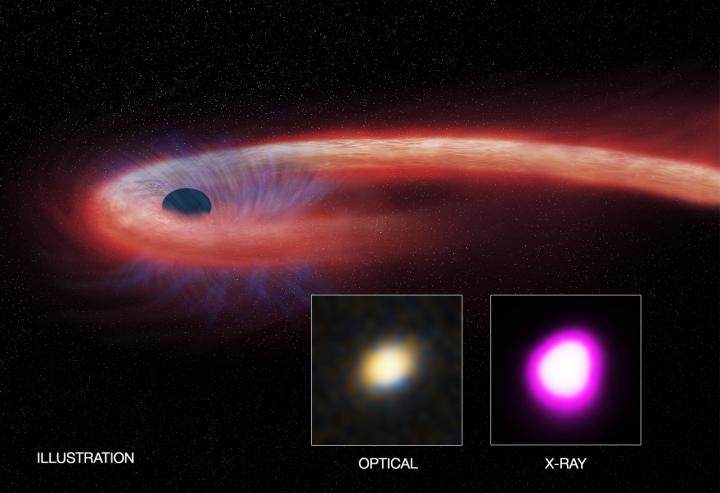

Artist illustration depicting the record breaking "tidal disruption event" (TDE). The red shows hotter material that falls toward the black hole and generates a distinct X-ray flare. The blue shows a wind blowing from the infalling material.
Credit: CXC/M. Weiss; X-ray: NASA/CXC/UNH/D. Lin et al, Optical: CFHT
“We have witnessed a star's spectacular and prolonged demise,” said Dacheng Lin, a research scientist at UNH's Space Science Center and the study's lead author. “Dozens of these so-called tidal disruption events have been detected since the 1990s, but none that remained bright for nearly as long as this one.”
Using data from a trio of orbiting X-ray telescopes, NASA's Chandra X-ray Observatory and Swift Satellite as well as ESA's XMM-Newton, researchers found evidence of a massive “tidal disruption event” (TDE). Tidal forces, due to the intense gravity from the black hole, can destroy an object – such as a star – that wanders too close. During a TDE, some of the stellar debris is flung outward at high speeds, while the rest falls toward the black hole. As it travels inward, and is ingested by the black hole, the material heats up to millions of degrees and generates a distinct X-ray flare.
These multiwavelength flares, which can be viewed by the satellites, help to study otherwise dormant massive back holes. Previous flares were short-lived, typically becoming very faint in a year, but this super-long X-ray flare has been persistently bright for close to a decade. The extraordinary long bright phase of this TDE means that either this was the most massive star ever to be torn apart during one of these events, or the first where a smaller star was completely torn apart.
The X-ray source containing this force-fed black hole, known by its abbreviated name of XJ1500+0154, is located in a small galaxy about 1.8 billion light years from Earth.
The X-ray data also indicates that radiation from material surrounding this black hole has consistently surpassed the so-called Eddington limit, defined by a balance between the outward pressure of radiation from the hot gas and the inward pull of the gravity of the black hole.
The conclusion that supermassive black holes can grow, from TDEs and perhaps other means, at rates above those corresponding to the Eddington limit has important implications. Such rapid growth may help explain how supermassive black holes were able to reach masses about a billion times higher than the sun when the universe was only about a billion years old.
Based on the modeling by the researchers the black hole's feeding supply should be significantly reduced in the next decade and begin to fade in the next several years.
###
A paper describing these results appears in the February 6 issue of the journal Nature Astronomy which can be viewed here: http://www.
Lin received support for this work from NASA (Chandra Award Number GO5-16087X). The Chandra X-ray Observatory is operated by the Smithsonian Astrophysical Observatory for and on behalf of NASA.
The University of New Hampshire is a flagship research university that inspires innovation and transforms lives in our state, nation and world. More than 16,000 students from all 50 states and 71 countries engage with an award-winning faculty in top ranked programs in business, engineering, law, liberal arts and the sciences across more than 200 programs of study. UNH's research portfolio includes partnerships with NASA, NOAA, NSF and NIH, receiving more than $100 million in competitive external funding every year to further explore and define the frontiers of land, sea and space.












